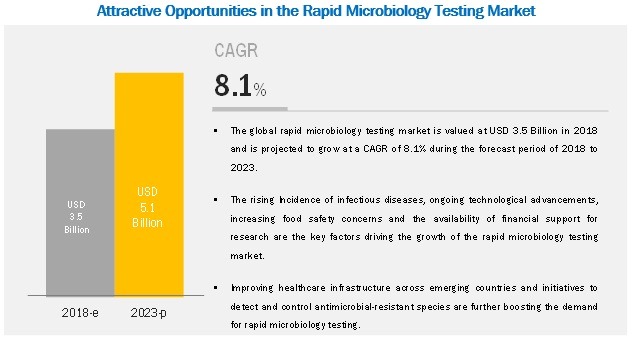The major factors driving the growth of the rapid microbiology testing market include the rising prevalence of infectious diseases; ongoing technological advancements; increasing food safety concerns; and increased funding, research grants, & public-private investments.
According to the recent report “Rapid Microbiology Testing Market by Method (Growth, Viability), Product (Automated Microbial Identification & AST System, PCR, Reagent), Application (Clinical Diagnosis, Environmental), End User (Labs, Hospitals, Industry) – Global Forecast to 2023” published by MarketsandMarkets™, is expected to reach USD 5.09 billion by 2023 from USD 3.45 billion in 2018, at a CAGR of 8.1%
Browse in-depth TOC on “Rapid Microbiology Testing Market”
90 – Tables
42 – Figures
188 – Pages
Download PDF Brochure: https://www.marketsandmarkets.com/pdfdownloadNew.asp?id=31548521

The instruments segment is expected to account for the largest share of the products market in 2018
On the basis of product, the rapid microbiology testing market is segmented into instruments, reagents & kits, and consumables. The instruments segment is further categorized into automated ID/AST systems, mass spectrometers, PCR systems, bioluminescence- and fluorescence-based detection systems, cytometers, active air samplers, and other instruments. The automated microbial ID/AST systems segment is expected to command the largest share of the global rapid microbiology testing market in 2018. This is primarily due to the ability of these systems to produce rapid, accurate, reliable, and cost-effective results.
Growth-based rapid microbiology testing is expected to account for the largest share of the market, by method, in 2018
Based on method, the global rapid microbiology testing market is classified into segments growth-based, viability-based, cellular component-based, nucleic acid-based, and other rapid microbiology testing methods. The growth-based segment is expected to account for the largest share of the rapid microbiology testing market in 2018. The large share of this segment can be attributed to factors such as the ease of processing (this method uses conventional liquid or agar media), the limited requirement of skilled professionals, and supportive government regulations.
What Drives the Market?
The growth of the global market for Rapid Microbiology Testing is primarily influenced by the following factors:
· Rising Incidence of Infectious Diseases
· Technological Advancements
· Increasing Food Safety Concerns
· Funding, Research Grants, and Public-Private Investments
· Government Initiatives for the Detection of Antimicrobial Resistance
Request Research Sample Pages: https://www.marketsandmarkets.com/requestsampleNew.asp?id=31548521
North America is expected to dominate the rapid microbiology testing market during the forecast period.
Geographically, the market is segmented into North America, Europe, Asia Pacific, and the Rest of the World. North America is expected to account for the largest share of the global rapid microbiology testing market during the forecast period (2018–2023). The large share of this market can be attributed to the growing technological advancements in the field of rapid microbial testing, rising incidence of infectious diseases, and growing food safety concerns. In addition, the region has supportive government initiatives that help create awareness and promote the adoption of advanced microbial testing devices among key end users, thereby propelling the growth of the rapid microbiology testing market in North America.
The major players operating in the rapid microbiology testing market include bioMérieux SA (France), Danaher Corporation (US), and Becton, Dickinson and Company (US), among others.


